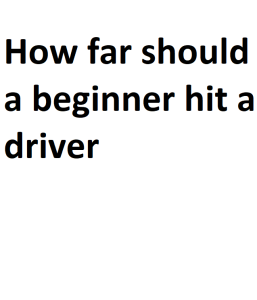As a beginner in golf, one of the most exciting aspects of the game is learning how to hit the driver, the club designed for maximum distance off the tee. While professional golfers can consistently hit the ball over 300 yards, beginners should set more realistic expectations. In this guide, we’ll explore how far a beginner should aim to hit a driver and the factors that influence this distance.
Factors Affecting Driver Distance for Beginners
Several factors come into play when determining how far a beginner should hit a driver:
- Swing Speed: Swing speed is a crucial determinant of driving distance. Beginners typically have slower swing speeds compared to experienced golfers. A typical beginner’s swing speed may range from 70 to 90 mph, whereas professionals can exceed 110 mph. Slower swing speeds result in shorter drives.
- Clubhead Speed: Clubhead speed directly affects the distance the ball travels. A driver with a faster clubhead speed will produce longer shots. Beginners often have a lower clubhead speed due to their developing swing mechanics.
- Technique and Mechanics: Proper swing mechanics are essential for generating distance. Beginners may struggle with swing consistency, balance, and timing, which can limit their ability to maximize distance.
- Equipment: The type of driver and golf ball used can impact distance. Beginner drivers often have larger clubheads and more forgiveness, which can help mitigate mishits and increase distance. Using a lower-compression golf ball can also benefit beginners in achieving longer drives.
Realistic Distance Expectations for Beginners
While every beginner’s situation is unique, here are some general distance expectations for beginners using a driver:
- Total Distance: On average, beginners can expect to hit a driver between 150 and 200 yards. This range accounts for variations in swing speed, technique, and physical fitness.
- Roll and Carry: The total distance can be broken down into carry (the distance the ball travels through the air) and roll (the distance the ball rolls after landing). Beginners may achieve a carry distance of 120-150 yards and a total distance of 150-200 yards, depending on the conditions and terrain.
- Improvement Over Time: As beginners practice and refine their skills, they can expect to gain distance with their driver. Incremental improvements in swing speed, mechanics, and equipment can lead to longer drives.
Tips for Increasing Driver Distance as a Beginner
If you’re a beginner looking to increase your driver distance, consider these tips:
- Take Lessons: Invest in golf lessons with a certified instructor to improve your swing mechanics and overall technique.
- Fitness and Flexibility: Work on your physical fitness and flexibility to increase your swing speed and power.
- Proper Equipment: Get properly fitted for golf clubs, including your driver, to ensure they match your swing characteristics.
- Practice Regularly: Consistent practice, both on the driving range and on the course, is essential for improvement.
- Understand Course Management: Learning to make smart decisions on the course can help you maximize distance by placing your ball in advantageous positions.
Setting Personal Goals
While general guidelines can help beginners understand what to expect, it’s essential to remember that golf is a highly individualized sport. As a beginner, you should focus less on comparing yourself to others and more on setting personal goals for improvement. Here are some steps to consider:
- Baseline Measurement: Start by assessing your current driving distance. Use a launch monitor or consult with a golf professional to get accurate data on your swing speed and carry distance with the driver. This will provide a starting point for your improvement journey.
- Short-Term and Long-Term Goals: Establish both short-term and long-term goals for your driving distance. Short-term goals might involve gaining an extra 10 yards over a few months, while long-term goals could be focused on reaching specific yardage milestones in a year or two.
- Work on Weaknesses: Identify the aspects of your game that are limiting your distance. It could be swing mechanics, physical fitness, or even mental aspects. Work on these weaknesses systematically to achieve your goals.
- Track Progress: Regularly measure and track your progress. This will not only keep you motivated but also help you make necessary adjustments to your practice routine.
Importance of Accuracy and Consistency
While it’s tempting to focus solely on distance, it’s crucial to emphasize accuracy and consistency with your driver. Hitting the fairway consistently is often more valuable than sheer distance. Here’s why:
- Fairway Control: Hitting the fairway off the tee sets up easier approach shots and increases the likelihood of scoring well. In some cases, it’s better to sacrifice a bit of distance for the sake of accuracy.
- Avoiding Trouble: Longer drives can also lead to trouble if they go off target. Beginners should prioritize keeping the ball in play and avoiding hazards.
- Lower Scores: Scoring in golf is about more than just driving distance. A well-rounded game that includes reliable driving, strong iron play, and solid putting will ultimately lead to lower scores.
Conclusion
In conclusion, while beginners in golf may not achieve the same driving distances as professional players, it’s essential to set realistic expectations based on individual factors such as swing speed, technique, and equipment. Setting personal goals, tracking progress, and focusing on accuracy and consistency are key to improving your driver distance.
Remember that golf is a journey, and improvement takes time. Enjoy the process, seek guidance from professionals when needed, and practice diligently. As you continue to refine your skills and gain experience, you’ll find that your driver distance will naturally improve, enhancing your overall enjoyment of the game.


